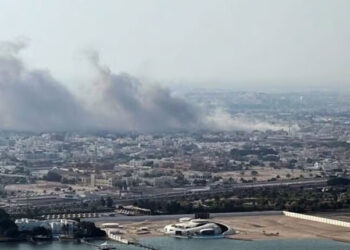Makkah, Saudi Arabia – With voices echoing “Labbayka Allahumma Labbayka” across the sacred plains, millions of Muslims from around the world, including 115,000 pilgrims from Pakistan, will today participate in the most significant rite of Hajj 2025—Wukuf-e-Arafah. This spiritually transformative ritual, held on the 9th of Dhul-Hijjah, is often referred to as the main pillar of Hajj and is considered a day of forgiveness, mercy, and divine closeness.
What Is Wukuf-e-Arafah and Why Is It the Pinnacle of Hajj?
The term Wukuf means “standing” and Arafah is a plain located approximately 20 kilometers east of Makkah. The rite involves pilgrims standing in prayer and reflection between Zuhr and Maghrib (midday to sunset), pleading for Allah’s mercy and forgiveness.
Significance in Islam:
- The Prophet Muhammad (PBUH) said: “Hajj is Arafah.” (Sunan al-Tirmidhi)
- It was on this plain that the Prophet delivered his final sermon (Khutbah al-Wida) more than 1400 years ago.
- Wukuf-e-Arafah is so critical that if missed, Hajj becomes invalid, highlighting its foundational importance.
Preceding the Day of Arafah: Arrival in Mina
Before proceeding to Arafah, all pilgrims—dressed in the sacred white garments of Ihram—first traveled to Mina, a tent city on the outskirts of Makkah.
Activities in Mina:
- Pilgrims offered five daily prayers—Zuhr, Asr, Maghrib, Isha, and Fajr—in congregations.
- This night in Mina is often used for spiritual preparation, recitation of Dua, and introspection ahead of the pivotal day of Arafah.
After performing the Fajr (pre-dawn) prayer on the 9th of Dhul-Hijjah, pilgrims left Mina early in the morning and proceeded towards the plain of Arafah for the main ritual of Wukuf.
At the Plain of Arafah: Sermon and Prayers at Masjid Nimrah
Upon arrival at Arafah, pilgrims gathered at Masjid Nimrah, where the Hajj sermon (Khutbah of Arafah) is delivered. The sermon is broadcast live and simultaneously translated into multiple languages, allowing millions around the world to benefit from its spiritual message.
Key Activities:
- Combined Zuhr and Asr prayers are offered shortly after the sermon.
- Between Asr and Maghrib, pilgrims engage in deep spiritual reflection, raising their hands in intense supplication (Dua) to Allah.
This period of standing is the essence of Wukuf-e-Arafah, where every pilgrim prays for their own forgiveness, the forgiveness of loved ones, and peace for all humanity. It is believed that on this day, Allah descends to the nearest heaven, boasting of His servants to the angels and grants forgiveness to sincere seekers.
Departure for Muzdalifah at Sunset
As the sun sets over Arafah, a symbolic announcement or cannon blast (Gola) marks the end of Wukuf. Without offering Maghrib prayer at Arafah, the pilgrims depart immediately for Muzdalifah—a vast open plain between Arafah and Mina.
At Muzdalifah:
- Pilgrims offer combined Maghrib and Isha prayers upon arrival.
- They spend the night under the open sky, sleeping on the ground without tents.
- During this time, they also collect 49 or 70 small pebbles, which will be used for the Ramy (stoning ritual) at Jamarat.
The night at Muzdalifah reflects simplicity, humility, and unity, as millions of believers sleep side by side, erasing all worldly distinctions.
Return to Mina: Stoning of the Devil and Sacrifice
After offering Fajr prayer at Muzdalifah, the pilgrims return to Mina at sunrise. The 10th of Dhul-Hijjah marks the first day of Eid al-Adha, and three significant rituals are observed on this day:
1. Ramy al-Jamarat (Stoning the Devil):
- Pilgrims throw seven pebbles at the largest pillar, Jamarat al-Aqaba, symbolizing their rejection of evil and temptation.
2. Qurbani (Sacrifice):
- Following the stoning, pilgrims perform the ritual animal sacrifice, commemorating Prophet Ibrahim’s willingness to sacrifice his son in obedience to Allah.
3. Halq or Taqsir (Shaving the Head or Haircut):
- Men shave their heads (Halq), while women cut a small portion of hair (Taqsir) as a sign of spiritual renewal.
After completing these rites, pilgrims remove their Ihram, change into regular clothes, and begin to transition back to daily life—reborn and spiritually cleansed.
The Days of Tashreeq: Continued Worship in Mina
Pilgrims remain in Mina for the 11th and 12th of Dhul-Hijjah, known as the Days of Tashreeq.
Activities Include:
- Ramy al-Jamarat is performed again, but this time at all three pillars—the small, medium, and large devils—using seven pebbles each.
- This ritual is repeated on the 12th of Dhul-Hijjah, and pilgrims may then choose to leave Mina before sunset or remain for one more day.
Those who opt to stay perform the ritual once more on the 13th of Dhul-Hijjah, marking the conclusion of the formal Hajj rites.
Tawaf al-Ifadah and the Final Farewell
Following the stoning rituals, pilgrims return to Makkah to perform the Tawaf al-Ifadah, one of the essential rites of Hajj, where they make seven counterclockwise circuits around the Kaaba. This act signifies submission, love, and devotion to Allah.
Before leaving Makkah, pilgrims also perform the Tawaf al-Wada—a farewell circumambulation of the Kaaba, symbolizing a heartfelt goodbye to the holiest site in Islam.
Post-Hajj Journey: Visiting the Prophet’s Mosque in Medina
While the formal rites of Hajj conclude in Makkah, many pilgrims opt to travel to Medina, the city of the Prophet Muhammad (PBUH), to offer prayers at Masjid al-Nabawi and visit the Prophet’s resting place.
This visit, though not mandatory for Hajj, is considered a highly recommended Sunnah and is filled with spiritual blessings.
Global Participation and Significance
Hajj is one of the five pillars of Islam, and every financially and physically able Muslim is obligated to perform it once in a lifetime. This year, millions of pilgrims from around the globe, including over 115,000 Pakistani pilgrims, gathered in Saudi Arabia to fulfill this sacred obligation.
The event serves as a unifying experience, breaking down barriers of race, nationality, and social status. Pilgrims wear simple white garments to symbolize equality and humility before God.
Conclusion: Hajj – A Journey of Spiritual Transformation
As the rituals of Hajj conclude, pilgrims return to their homelands with renewed faith, spiritual clarity, and a cleansed soul. The phrase “Labbayka Allahumma Labbayka”—meaning “Here I am, O Allah, here I am”—continues to resonate in their hearts, a testament to their devotion, obedience, and love for the Creator.
With millions performing the rites in unison, Hajj remains a profound expression of Islamic unity, discipline, and spirituality.

























